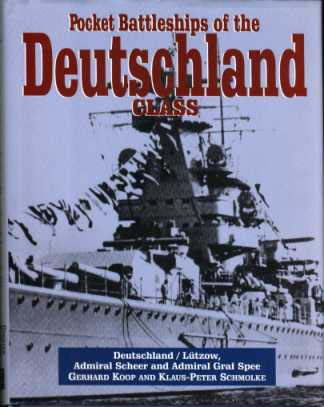 Pocket Battleships of the Deutschland Class Pocket Battleships of the Deutschland Class
By Gerhard Koop & Klaus Peter Schmolke
GreenHill Books/Naval Institute press
©2000 ISBN 1-85367-402-8 by Ray Boorman This book is the latest in a series that has covered all the major classes of the Kreigsmarine in World War 2. The books dimensions are 8" by 10" and 224 pages. These contain more than 300 Photographs, plans and diagrams. The book is divided into three major sections. An introductory chapter begins the first section and covers the reasons for the Pocket Battle Ship design. In doing this you get a better understanding of the restrictions that had to be worked around in the design of the ships and more importantly why. Some of these restrictions would both challenge the designers and later haunt the ships in there operational lives. Of special interest in this chapter is the work that went into the development of the Diesel propulsion system and the infighting that took place around the various factions proposing Diesel or the more tried and true Steam driven but shorter ranged capital ships. Whilst the Diesel designs encountered tremendous teething problems, in the end the engines were very successful and allowed the Pocket Battleships their tremendous range and operational capability. Following the introductory chapter there are short but detailed chapters on Armour, Armament, Fire Control and Radar, Machinery, Refits and Ships Data. The first section takes up the first 50 pages. As brief as this is, it does cover a lot of detail with both drawings and text. Unfortunately the small size of the book works against the plans and drawings. The drawings are useful but a larger format or foldouts would have been preferred. Whilst there are 5 drawings showing ships in camouflage they are not in colour and are not up to some of the types of publications that concentrate on this facet. The Second and largest section of the book, is made up of almost 170 pages divided into 3 chapters one for each ship. There is a brief history for each ship followed by many pages of photographs. For modelers these photos are really the gravy. There are many detailed shots that are just what you need to know which detail was on which ship and when. Again the only problem is the size of the book, a larger format might have allowed larger photographs. Of course this isn't always the case some publishers have been known to enlarge a photo to the point where it looses clarity. This isn't the case in this book, all the photos are clear and well printed. You will spend hours looking at the photographs. The last small section consists of a Bibliography (Why do so many books nowadays not have this), Index and a chapter that attempts to draw conclusions on both the success and failures of these ships. This Chapter by itself is a jewel since it looks at many facets to draw its conclusions. I picked up this book out of curiosity, this class of ships is both famous and enigmatic but also not the easiest to find information on. I found the book to be both a good read, comprehensively detailed and full of information that both modelers and Naval Buffs can use. In fact it has got me so interested in this class of ships that I have dropped my wwi aircraft models for a while and bought an Italeri Deutschland and some Gold Medal Photo Etch to build my first 1/700 ship. All in all this book is highly recommended | 

 




|